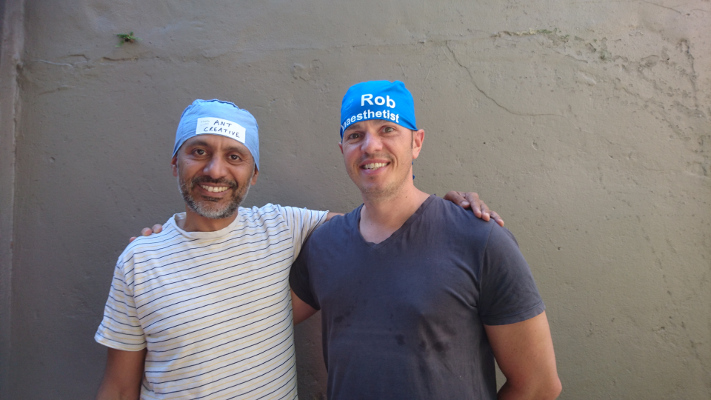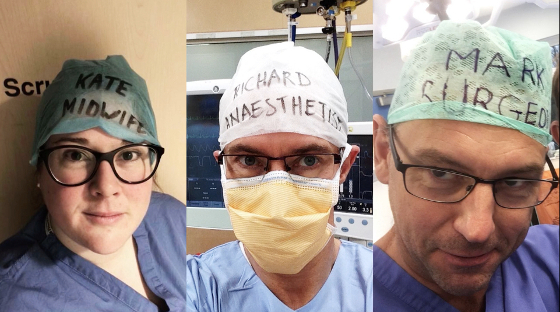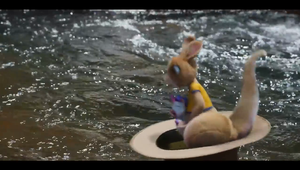
How the #TheatreCapChallenge is Saving Lives

Don’t show this to anyone who is about to go under the knife, but according to recent research, medical errors could be the third leading cause of death in the US, behind heart disease and cancer.
In operating theatres, where stakes are high and one’s life lies quite literally on a knife’s edge, most adverse events are due to communications problems. Quite often surgical teams can be a fairly large group of surgeons, medics, nurses and technicians who can be hard to identify behind the scrubs and masks. Add to that the fact that surgeries may bring together people from different departments or different hospitals who may never have met and it’s unsurprising that it can be difficult to identify and keep track of team members.
A passionate advocate for patient safety, Australian anaesthetist Dr. Rob Hackett, had grown frustrated about the confusion and miscommunication of the operating theatre. In response he established the PatientSafe Network. And then came a deceptively simple idea with the potential to change everything – Dr. Rob decided to write his name on his cap.
And so, the Theatre Cap Challenge was born back in February 2017. The idea took off, propagated on social media and through the PatientSafe Network. Over the past year the practice has been adopted by teams from Russia to China. Scrubs manufacturers have even started offering personalised surgical caps.
Ant Melder, ECD at Host/Havas in Sydney helps PatientSafe as a creative consultant – Dr. Rob is his brother-in-law and when Ant heard the idea he wanted to do what he could to help support it. LBB’s Laura Swinton caught up with Ant to find out more about this extraordinary journey.
LBB> How did your relationship with The PatientSafe Network come about?
AM> Dr. Rob Hackett, an anaesthetist here in Sydney, is my brother-in-law. Over the years he's worked in lots of different hospitals and he regularly comes across many ways in which these environments are not as safe as they could be: outdated, potentially dangerous equipment; very different medicines in almost identical and, therefore, easy to mix up packaging; incorrect procedures being followed through lack of training/awareness. To kickstart a change for the better, he founded The PatientSafe Network in 2016. I've been supporting Rob as a creative consultant basis since the founding of the organisation.
LBB> And I imagine that there are so many potential avenues to go down when it comes to improving patient safety in the operating theatre… how did you narrow it down to communication and identification? Was there an ‘aha’ moment or was it about painstakingly exploring all the possibilities?
AM> As a medical professional, it was Rob who spotted the need for improved communication in theatres and told me about his plan to start writing his name on his scrub cap. I recognised the potential for this simple behaviour change idea to take off and supported him through helping to get the initiative to spread across social media. Once these first steps had been taken, British junior midwife Alison Brindle came up with the hashtag #TheatreCapChallenge, which helped the initiative spread further and quicker across social media. Then, mainstream media picked up the story and the idea grew exponentially. Meanwhile, we've pushed for more social media engagement as we try to drive the idea further into the mainstream.
In terms of exploring possibilities, there's a whole suite of further patient safety ideas that we're developing. We see the Theatre Cap Challenge as just one initiative among a great number which will, in time, create a revolution in patient safety.
LBB> The idea is almost ridiculously simple! How did you come to that?
AM> Rob had always been frustrated by communications issues in operating theatres. He didn't find it surprising at all that the World Health Organisation had reported that communications issues were the root cause of nearly 70% of adverse events between 1995 and 2005. One time, he was called to a cardiac arrest outside operating theatre. On seeing his hat and that he was an anaesthetist it was automatically assumed he would coordinate the arrest. There were 20 other staff who arrived at the arrest too - none of them whose names or roles he knew. He describes the difficulty in even getting someone to pass him a pair of gloves in this melee of unidentifiable people.
LBB> And when you landed on the idea, were you worried whether medical staff would willingly want to do such a thing, or were you all pretty sure that diligent medics would adopt it?
AM> Surprisingly, although there was a lot of positivity, there was also lots of pushback when Rob first started writing his name and role on his scrub cap - from other front-line staff and medical authorities. Some felt the name caps looked unprofessional, some thought it was unnecessary, some just didn't like the idea, some laughed and said to Rob - "What's wrong - can't you remember your own name?" As the idea caught on, the negativity died down. However, there still remains some hesitation/dubiousness among some senior medical staff and authorities.

LBB> Dr Robert Hackett and midwife Alison Brindle were key figures in developing and driving the project – what roles did they play?
AM> Rob initiated the idea; Alison played a key role in helping it take off by coming up with the #TheatreCapChallenge hashtag; I've played a supporting role as creative consultant. But truly, it's less about who did what individually and more about scores if not hundreds of others who've been instrumental in turning a simple act into a global movement - those who've championed the idea, those who've spread it on social media and the cap manufacturers who've come to the party.
LBB> So, once you came up with the idea, how did you get it out there?
AM> Social media, word of mouth, PR. Rob is incredibly active on The PatientSafe Network blog and Twitter account. Because it's such a simple behaviour change it's been able to spread from the ground up, like a true grass roots movement.
LBB> I searched #TheatreCapChallenge and I was amazed to see how many local hospitals and medical organisations around the world have picked it up! What’s been the most surprising place that you’ve heard about?
AM> It's been popular in Russia. China's been big. And South Korea. Perhaps it'll find a way to make its way over the border into North Korea next...

LBB> It’s also cool to see people really take ownership of the idea and start printing their own named caps – what was your reaction when you saw that?
AM> That's been brilliant. Rob negotiated with a company in Sydney called Hunter Scrubs for them to start offering bespoke name hats. Here's a link. And since then, many other cap manufacturers/suppliers have come on board. Which has been awesome.
LBB> How long has the whole #TheatreCapChallenge journey been?
AM> Rob's first day wearing his scrub cap with his name on it was in February 2017. It took a while to gain traction but, once it did, it grew rapidly. Now we feel we are close to a tipping point.
LBB> What sort of feedback have you had from doctors, nurses etc about how the named caps has changed things in operating theatres?
AM> The response has been overwhelmingly positive. It feels like an idea whose time has come - a movement even. As above there have been pockets of dubiousness but, overall, front line staff in all kinds of different roles in medical institutions across the globe have embraced and championed it.
LBB> What next for the PatientSafe network?
AM> We're looking to push the idea to a tipping point, where name caps become the norm in theatres. And beyond this, we want to lobby authorities to bring in legislation that makes name caps mandatory.
Beyond that, there's a whole range of patient safety initiatives that we're working on. Some are simple behaviour change ideas, some involve new labelling/packaging of medicines, some involve using different kinds of equipment in hospitals. And the big one we're working on is a gamification idea which pulls all of the individual initiatives together in a fun but effective way. As I said above, the aim and ambition is to create a revolution in patient safety.
Writing The Wrongs - Credits
Key Project Team
Dr Robert Hackett – Founder, PatientSafe Network
Alison Brindle – Student Midwife
Dr Rhys Thomas - Anaesthetist
Ant Melder – ECD, Host/Havas Sydney
Chris Pointon - #hellomynameis
Dr Zoe Burton - Anaesthetist
Dr Gordon French - Anaesthetist
Jo Lever - Nurse
Dr Sethina Watson - Anaesthetist
Danielle Carey - Midwife
Jenny the M - Midwife
Dr Liz O’Riordan - Surgeon
Dr Peter Brennan - Surgeon
Dr Matt Turner - Anaesthetist
Richard - Nurse
Beth - Anaesthetic Assistant
Hunter Scrubs, ZigZagz, Etsy, ByLozza, TimHats, Scrubs.com, KimKaps, Gig Harbor
Market - Hats
Monique Pardavi – Head of Broadcast & Print Production, Host/Havas Sydney
Beau Williams – Editor, Host/Havas Sydney
Andrew Perry – Producer, Host/Havas Sydney
Frank Molina – Senior Designer, Host/Havas Sydney
Nic Adamovich - Senior Designer, Host/Havas Sydney













